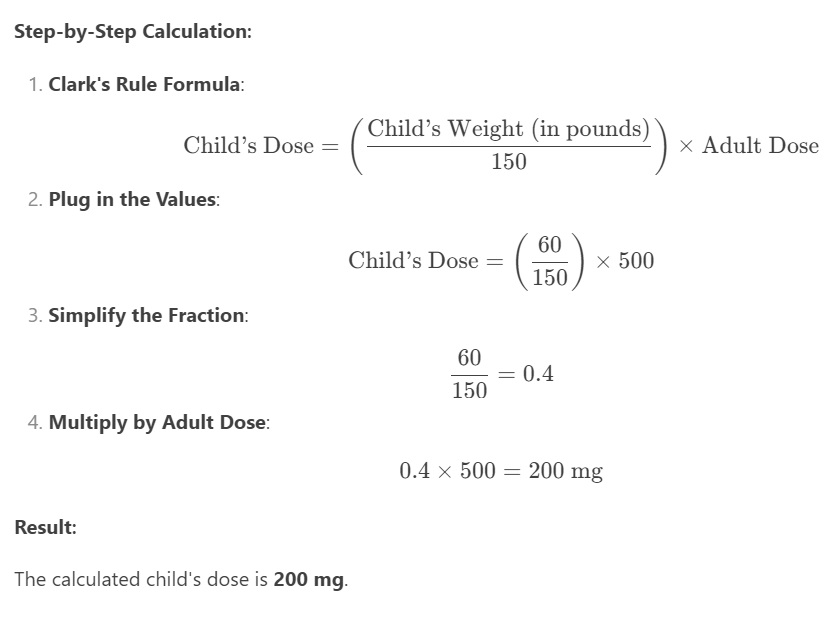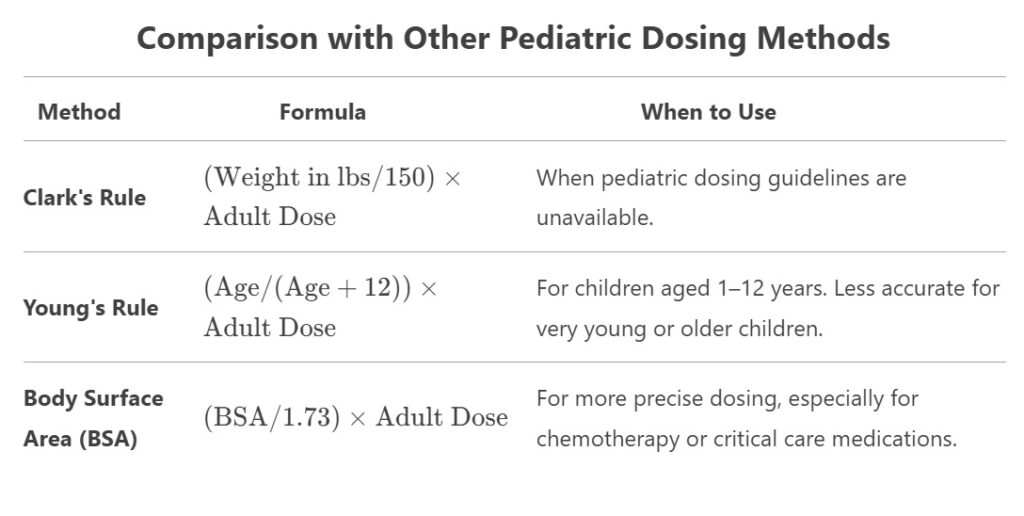Clark's Rule Calculator, Formula and Dosing
Clark's Rule Calculator
How Clark’s Rule Calculator Works?
Step 1: User’s are supposed to enter the required information:
- Child’s Weight: The weight of the child in pounds (e.g.,50 pounds.
- Adult Dose: The standard dose of the medication for an adult in milligrams (e.g., 300 mg).
Step 2: Click the Calculate Child’s Dose Button
- After entering the values, the user clicks the “Calculate Child’s Dose” button.
Step 3: Display Results
The calculator displays the results: The calculated child’s dose (e.g., 100.00 mg).
Step-by-Step Explanation:
- Child’s Weight: 50 pounds.
- Adult Dose: 300 mg.
- Formula Used: (Child’s Weight / 150) × Adult Dose.
- Calculation: (50 / 150) × 300 = 100.00 mg.
What is Clark’s Rule Method
Clark’s Rule is a method used to calculate the appropriate dosage of medication for children based on their weight and the standard adult dose.
It is particularly useful when pediatric dosing guidelines are not explicitly available.
Clark’s Rule History
Clark’s Rule is named after Dr. Cecil Clark, a British physician who introduced the formula as a method for estimating pediatric drug dosages. The rule was developed in the early 20th century as a simple way to calculate appropriate medication doses for children based on their weight relative to an average adult weight.
Key Points About Clark’s Rule:
- Origin: Introduced by Dr. Cecil Clark in the early 1900s.
- Purpose: To provide a quick and straightforward method for calculating pediatric doses when specific guidelines were not available.
- Assumption: The rule assumes an average adult weight of 150 pounds (approximately 68 kg), which was a common reference point at the time.
Historical Context:
- In the early 20th century, pediatric dosing guidelines were not as well-established as they are today.
- Clark’s Rule was one of the first attempts to create a standardized method for adjusting adult doses for children.
- Over time, more precise methods, such as body surface area (BSA) calculations and weight-based dosing, have been developed, but Clark’s Rule remains a useful tool in certain situations.
Clark’s Rue Applications:
- Pediatric Medicine: To estimate safe medication doses for children when pediatric-specific guidelines are unavailable.
- Emergency Situations: When quick calculations are needed, and detailed dosing charts are not accessible.
- Pharmacology Education: To teach students about dosage calculations and weight-based adjustments.
Limitations of Clark’s Rule:
- Not Universally Accurate: It assumes an average adult weight of 150 pounds, which may not apply to all populations.
- Age Considerations: It does not account for developmental differences in drug metabolism between children of different ages.
- Medication-Specific Factors: Some medications require more precise calculations based on body surface area (BSA) or other factors.
- Overestimation or Underestimation: The rule may overestimate or underestimate doses for very small or very large children.
Despite its limitations, Clark’s Rule is still taught in pharmacology and medical education as a foundational concept in pediatric dosing. It serves as a reminder of the importance of adjusting medication doses for children based on their size and developmental stage.
Clark's Rule Examples with Calculations
Example: A child weighs 60 pounds, and the standard adult dose of a medication is 500 mg. Use Clark’s Rule to calculate the appropriate dose for the child.

Explanation:
The child weighs 60 pounds, which is 40% of the assumed average adult weight of 150 pounds (60/150 = 0.4).
Therefore, the child’s dose is 40% of the adult dose (0.4 × 500 = 200mg).
Clark's Rule vs Young's Rule vs Body Surface Area (BSA)

Frequently Asked Questions about Clark's Rule Method
What is Clark’s Rule?
Clark’s Rule is a formula used to calculate the appropriate dose of medication for children based on their weight and the standard adult dose.
The formula is:

Who introduced Clark’s Rule?
Clark’s Rule was introduced by Dr. Cecil Clark, a British physician, in the early 20th century as a method for estimating pediatric drug dosages.
What is the average adult weight assumed in Clark’s Rule?
Clark’s Rule assumes an average adult weight of 150 pounds (approximately 68 kg).
When is Clark’s Rule used?
Clark’s Rule is used when:
- Pediatric dosing guidelines are unavailable.
- A quick estimate of a child’s medication dose is needed.
- Teaching or learning about pediatric dosage calculations.
Can Clark’s Rule be used for all medications?
No, Clark’s Rule should only be used when specific pediatric dosing guidelines are unavailable.
Some medications require more precise calculations based on body surface area (BSA) or other factors.
What is the main advantage of Clark’s Rule?
The main advantage is its simplicity and ease of use for quick calculations when pediatric dosing guidelines are unavailable.
What is the main disadvantage of Clark’s Rule?
The main disadvantage is its reliance on an assumed average adult weight of 150 pounds, which may not be accurate for all populations.
Can Clark’s Rule be used for infants?
Clark’s Rule is not ideal for infants because their drug metabolism differs significantly from older children and adults.
Specific pediatric dosing guidelines or weight-based calculations are preferred.
How accurate is Clark’s Rule?
Clark’s Rule provides a rough estimate and is not as accurate as methods like body surface area (BSA) calculations.
It should be used with caution and verified by a healthcare professional.
What are the alternatives to Clark’s Rule?
- Body Surface Area (BSA) Method: More accurate for precise dosing, especially for chemotherapy or critical care medications.
- Weight-Based Dosing: Uses the child’s weight in kilograms to calculate the dose.
- Young’s Rule: Uses the child’s age to estimate the dose.
